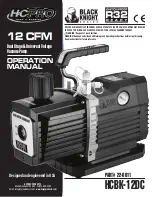
7
WARNING
: Before beginning pump
repair, all internal pressure must be
relieved. To reduce risk of personal
injury, follow the
Pressure Relief Pro-
cedure
shown on pages 2 & 8.
Removing the Air Motor
:
Using a 7/16"
wrench or socket, remove the four nuts (37) from
the carriage bolts (30). Pulling upward on the
handle (39), remove carriage bolts (30). Pull up
on cap (31) and slide cap (31) outward, removing
cap from tee slot connection with tripper rod (42).
Pull upward on body (33) and remove. Shift air
motor out from tee slot connector on rod (19) and
remove air motor, seal insert (35) and lower body
(36). Reassemble in reverse order,
using grease
(p/n 826733) on all seals and o-rings.
Pump Repair/Servicing
Replacing the Air Motor Seals (Installing
kit 900019):
Place air motor on clean work
surface with the air valve mechanism up. With
a straight screwdriver, remove the ball detent
retainers (55) from piston (ensure the balls (57)
are removed). With two 7/16" wrenches, remove
the two nuts (49) from the top of the intake valves
(62). Now, hold the tripper rod (42) and pull valve
bar assembly from piston (59). Check for wear
on all seals (32, 34, 54, and 58), balls (57), and
springs (46 and 47) and replace as required.
Reassemble in reverse order, using the diagram
as a guide.
Use grease (p/n 826733) on all seals
and o-rings.
Replacing the Lower End Seals (Installing
kit 900022):
Place a 3/32" allen wrench through
a slot in the intake tube (18) and through the
1/8" hole in the lower rod (26) as shown in fig. 1
below. While holding rod (26) in place with allen
wrench, remove nut (29) with a 5/8" socket. The
upper and lower intake disks (27 and 28) can now
be removed. Using a strap wrench, remove the
intake tube (18) and the high pressure cylinder
(12).
30). The foot seal
Fig. 1: Removing Grease Intake Assembly
!




































